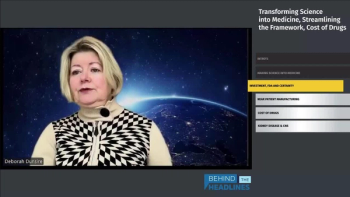
PTSM: Pharmaceutical Technology Sourcing and Management
- PTSM: Pharmaceutical Technology Sourcing and Management-01-08-2014
- Volume 10
- Issue 1
GDUFA Off to Good Start, But Storm Clouds on the Horizon
GDUFA is off to a good start from a facility inspection perspective, but there are storm clouds on the horizon.
Guest Editorial
The Generic Drug User Fee Act (GDUFA) was negotiated in 2011 with the hope of providing the Food and Drug Administration (FDA) with resources to conduct timely reviews of drug applications and inspection of drug-producing facilities. For the first time there was hope that we would be able to make significant strides in drug safety by making sure generic drugs produced in both foreign and domestic facilities would receive well-deserved scrutiny.
And GDUFA, signed into law in July 2012 by President Obama, is off to a good start from a facility inspection perspective, but there are storm clouds on the horizon due in large part to the current gridlock in Washington over the federal budget and sequestration.
Fees collected under GDUFA are intended to supplement FDA funding, not replace congressionally allocated resources. Sequestration has also deeply cut into FDA funding, and additional cuts may jeopardize FDA’s resources to a point that could result in industry’s discontinuation of payment of fees because GDUFA fees may not be spent if FDA funding falls below FY 2009 levels.
Implementing GDUFA
One of the most difficult aspects of establishing fees once an overall revenue goal is determined is to estimate the actual volume of drug master files (DMFs), prior approval supplements (PASs) and abbreviated new drug approvals (ANDAs), as well as the number of facilities to be inspected. One of the biggest hurdles encountered during GDUFA discussions was establishing these numbers so they could be applied to the total fees to be collected.
Application reviews are influenced by marketplace decisions, which make them difficult to predict. But in one area, we now have firm numbers that can be used to determine FDA resources needed to meet the negotiated goals of GDUFA. Generic drug facilities were required to self-register for FY 2013 and 2014. While there were some differences, the numbers did not vary much from year to year.
In FY 2013, 447 domestic facilities and 1,196 foreign facilities were registered while FY 2014 saw 443 domestic facilities and 1,208 foreign facilities being registered. This indeed highlights the very large number of drugs produced outside the US and provides FDA with a much improved data set that will improve resource allocations when it comes to facility inspections.
Diving a little deeper into the numbers reveals the extent to which generic APIs are being produced in foreign facilities. In FY 2013 and FY 2014, approximately 14 percent of the registered active pharmaceutical ingredient (API) facilities are located in the US. Finished dosage form (FDF) facilities show a more balanced global presence with approximately 42 percent of these facilities situated in the US.
What does this mean for GDUFA? With a congressionally mandated requirement to inspect these facilities every two years, the FDA has focused on domestic facilities because of limited resources. So, it came as a surprise to no one that foreign facilities received very little attention. In fact, many facilities were never inspected at all.
Conducting inspections at foreign facilities represents special challenges for the FDA. Language barriers, requirements for scheduling inspections (rather than surprise visits), and additional travel costs all increased the probability that these inspections became limited and less frequent. Fees collected under GDUFA will go a long way toward hiring and training additional inspectors, as well as providing funds for travel and improvement in IT systems that tracks the facilities so routine compliance inspections of foreign facilities can occur at the same frequency as domestic facilities.
It’s taken some time to get to this point. Now that FDA has a better handle on where generic drugs are being produced, the agency can better regulate the safe production of drugs throughout the supply chain. Yet once again, despite the best efforts of all stakeholders to put a system in place to enhance drug safety, this effort is at the mercy of Congress. Stay tuned.
John DiLoreto is the Executive Director of the Bulk Pharmaceuticals Task Force (BPTF), an industry trade organization for manufacturers of active pharmaceutical ingredients (APIs), their intermediates and excipients. BPTF is an affiliate organization of the Society of Chemical Manufacturers and Affiliates (SOCMA).
Articles in this issue
about 12 years ago
New Dynamics in Drug Pricing and Prescribingabout 12 years ago
Climate Change Drives New Opportunities in Outsourcingabout 12 years ago
BMS Grants Support Mental Health Needs of US Military Veteransabout 12 years ago
Cambrex Completes FDA Inspectionabout 12 years ago
Metrics Appoints New Vice-Presidentabout 12 years ago
Bridgepoint Development Capital Acquires Quotient ClinicalNewsletter
Get the essential updates shaping the future of pharma manufacturing and compliance—subscribe today to Pharmaceutical Technology and never miss a breakthrough.




